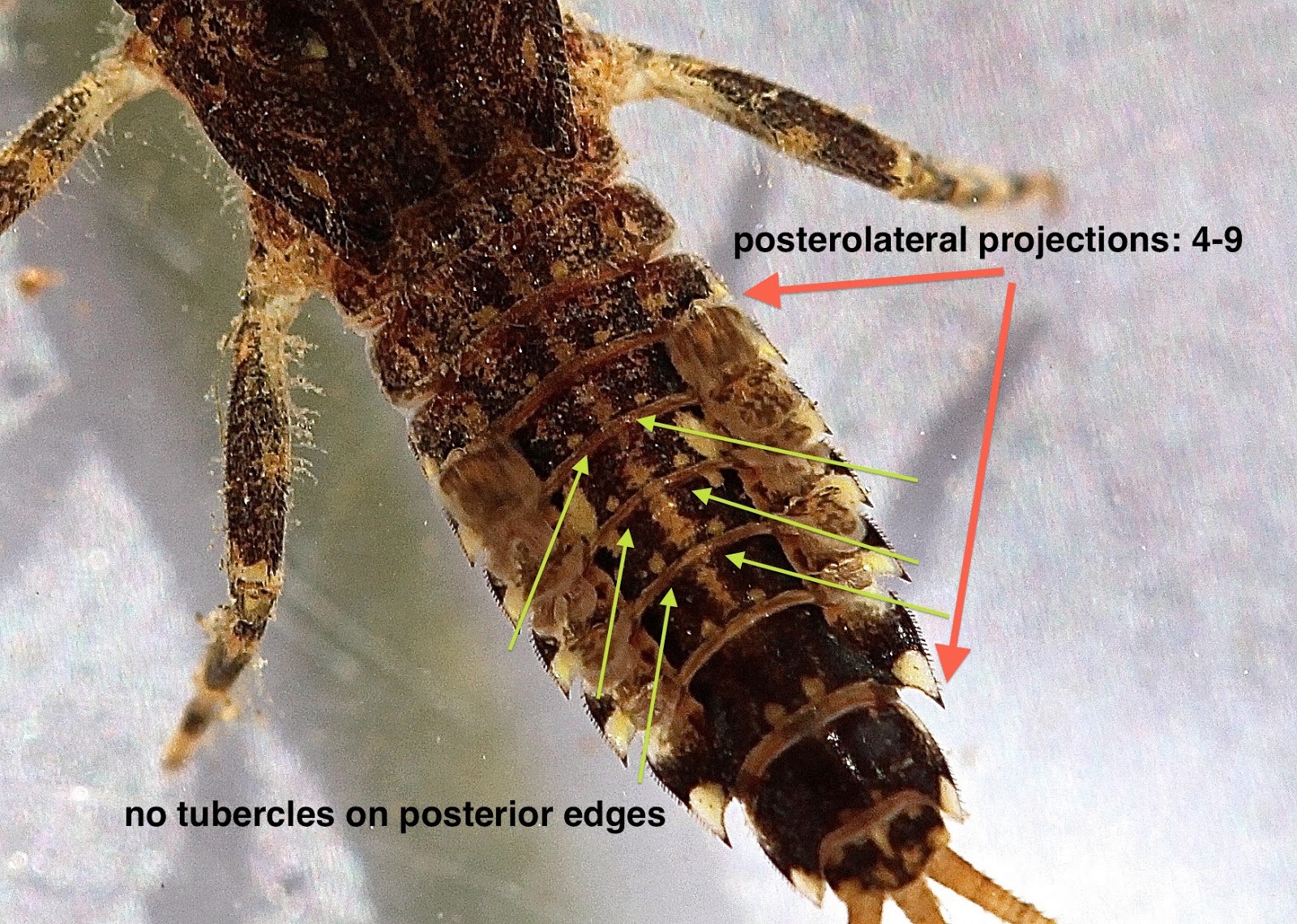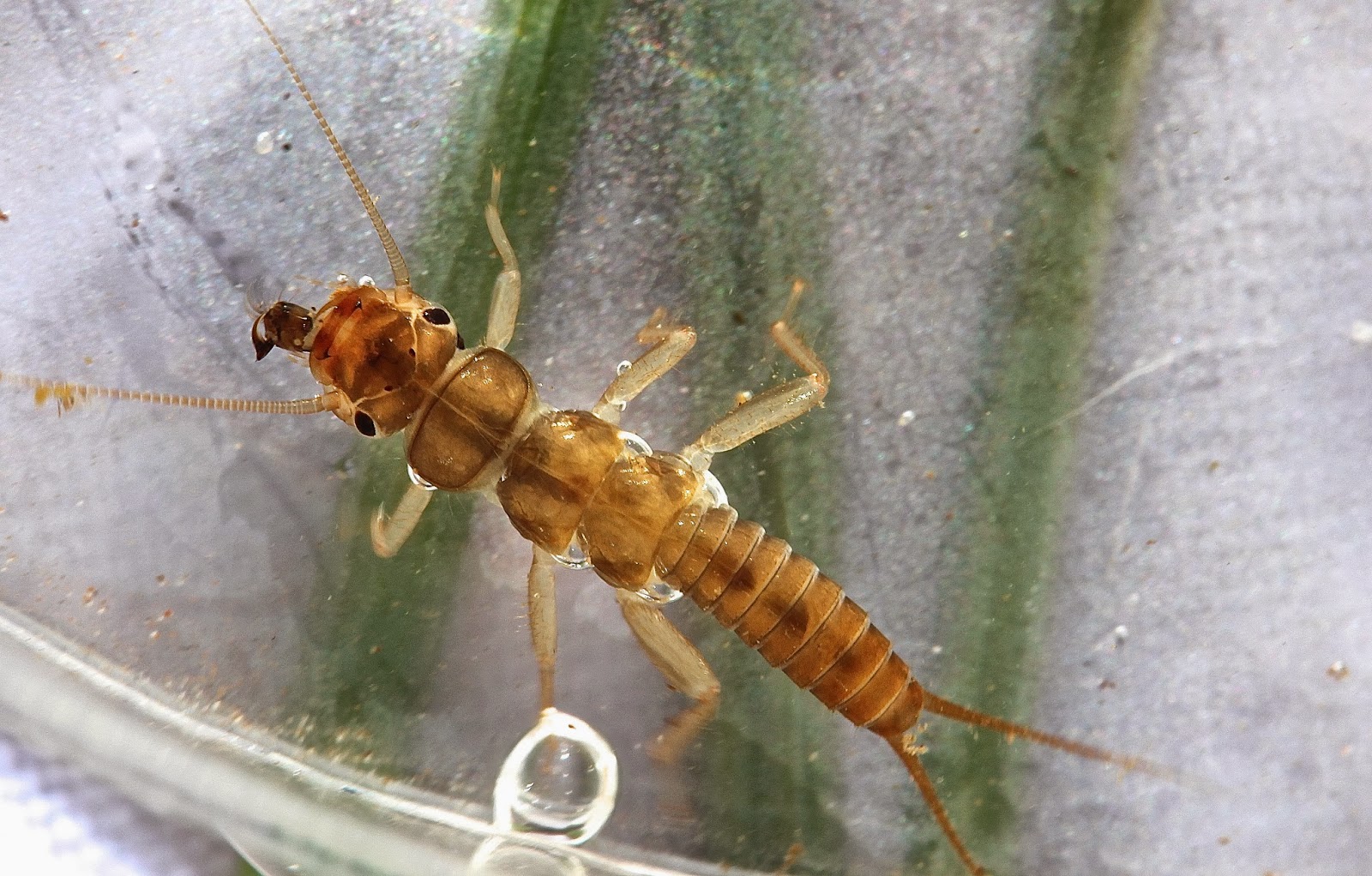Back to Sugar Hollow today while I continue to wait for the water levels to drop in larger streams -- I hope to make it to the Rapidan River on Monday. The stream for today -- a small one to which I've been only one time before. Here it is as it empties into the Moormans.
While I saw a lot of the insects I've been seeing in the other streams in this valley -- Uenoids, Giant stoneflies, Roach-like stoneflies, some Perlodids -- I was a little surprised to find a number of spiny crawlers, all of them dark brown with a pale dorsal stripe. I assumed they were E. invaria nymphs -- but I was wrong. They were E. dorothea, the species that we normally see in large numbers in April and May. There were no paired tubercles on the posterior edges of terga 4-9. (E. invaria has them.)
Our nymph:
E. invaria:
Let me quote from Beaty's description of E. dorothea. "E. dorothea -- nymphs 6-8 mm...terga without dorsal tubercles but may have slightly developed spiculate protuberances...lateral margins of terga 4-9 with posterolateral projections; lateral margins with slight, small serrations with numerous setae." Those serrated posterolateral projections are very clear in the photo above. He continues: "thorax and abdomen variable in pigmentation, light brown to dark brown, with or without pale speckles" -- i.e., some are speckled like this --
typically with paired posteromedial pale spots and sometimes with segments 5 and 6 pale mediad of gills; tergites may have a thin, pale mediodorsal stripe in some nymphs; caudal filaments banded."
The paired pale spots on the terga are very clear on our nymph, as is the pale mediodorsal stripe. While I'm not entirely sure what Beaty means by "mediad of the gills," terga 5 and 6 certainly differ from the rest and have pronounced pale spots close to the gills.
One final comment, "Darker, unspeckled nymphs -- ours fits that description -- may be a subspecies or possibly a color variant of E. dorothea but DNA analysis and/or adult associations are necessary to confirm." ("The Ephemeroptera of North Carolina," p. 27) So this "type" of E. dorothea that we find in the early part of the year could be a subspecies.
One of the other nymphs that I found this morning, this one clearly a male -- the eyes are turning red.
________________
And then there's the rest.
1. Giant stonefly, Pteronarcys proteus next to a young Perlodid stonefly, Clioperla clio.
2. A Roach-like stonefly -- Peltoperlid -- genus Tallaperla, probably the most common insect I see in these small mountain streams at this time of year.
3. Perlodid stonefly, Diploperla duplicata. In the first photo, munching away on a hapless black fly.
4. Large winter stonefly, Taenionema atlanticum. Lots of them around, and they're almost fully mature.
5. And a beautiful fingernet caddisfly larva, genus Dolophilodes. Note that the leading edge of the head -- the frontoclypeal apotome -- is asymmetrical.
________________
Uenoids. Their little stone cases were all over the place. I picked up 5 or 6 and photographed 3 or 4. When I got home and checked them for species ID, I was surprised to see that there were three different species represented in this small stretch of water: Neophylax oligius, Neophylax fuscus, and Neophylax concinnus. No big surprise to find oligius and fuscus together: we've seen that before. But most sources say that concinnus should be further upstream, in a different habitat altogether. (See Vineyard, et.al., The Caddisfly Genus Neophylax, p. 48.)
1. N. oligius. You can tell by the orange underside of the head.
2. N. fuscus. Note the muscle scars at the back of the head and under the eye. Also, the large, blade-like spines on the front of the pronotum were easy to see in a microscope view.
Lots to see in this small mountain stream.

























No comments:
Post a Comment